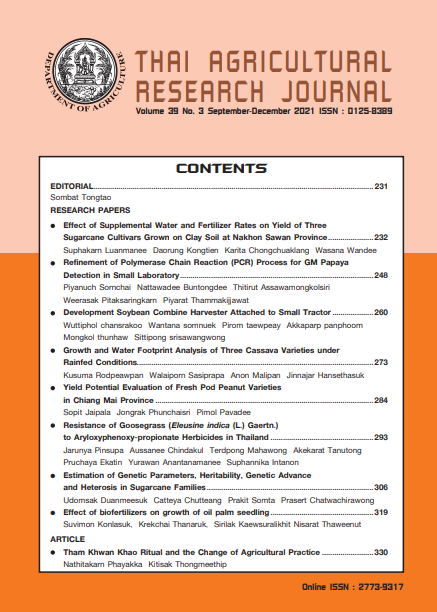Growth and Water Footprint Analysis of Three Cassava Varieties under Rainfed Conditions
DOI:
https://doi.org/10.14456/thaidoa-agres.2021.22Keywords:
growth, water footprint, cassava, rain areaAbstract
Growth and water footprint assessment of three cassava varieties: Rayong 5, Rayong 72 and Kasetsart 50 under rainfed condition was conducted at Rayong Field Crops Research Center, Muang District, Rayong Province. Cassava were planted in April 2018 and harvested in March 2019. Texture of the soil was loamy sand and 15-7-18 chemical fertilizer was applied at the rate of 50 kg/rai. Throughout the experiment, total rainfall, crop water used water used and effective rainfall were 1,662, 360.4 and 962 mm, respectively. Results showed a rapid increase in height and canopy width at 6 months after planting (MAP). Kasetsart 50 had the highest height and canopy width of 138 and 130 cm, followed by Rayong 5. Dry weight accumulation showed a markedly increased in to[1]tal mass at 4 to 8 MAP. At 4 MAP, Rayong 72 had the highest percentage of root dry weight accumulation at 68%, followed by Kasetsart 50 and Rayong 5 with 59.8 and 54.0%, respectively. At 8 MAP, Rayong 72 still had the highest accumulation up to 86.1% followed by Kasetsart 50 and Rayong 5 with 82.1%, and 76.5 %. Fresh roots yield of 3 cassava varieties showed that Rayong 72 gave the highest fresh roots yield of 5.43 ton/rai, followed by Kasetsart 50 and Rayong 5, gave fresh roots yield of 5.21 and 3.72 ton/rai, respectively. Average water footprint for 1 ton of cassava fresh roots yield was 144.1 m3 accounting for 111.9 m3 of green water footprint, and 32.2 m3 of gray water footprint. In summation, it was found that Rayong 72 had the lowest water footprint of 123.5 m3 , divided into WF green, WF blue and WF grey 95.9, 0 and 27.6 m3 , respectively, whereas Kasetsart 50 had 128.7 m3 /ton,dividedinto WF green WF blue and WF grey at99.9,0and28.8 m3 /ton, respectivelyand Rayong 5 had the highest 180.3 m3 /ton, divided into WF green WF blue and WF grey 140, 0 and 40.3 m3 /ton, respectively. Results showed that cassava varietysuitableforgrowingonloamysandsoil under rainfed condition in Rayong province was Rayong 72because it was more efficient in using water to produce fresh root yield per ton than Rayong 5 and Kasetsart 50.
References
คณะกรรมการสิ่งแวดล้อมแห่งชาติ. 2537. กำหนดมาตรฐานคุณภาพน้ำในแหล่งน้ำผิวดิน. แหล่งข้อมูล : http://slbkb.psu.ac.th/jspui/handle/2558/2373. สืบค้น: 20 เมษายน 2563.
ดิเรก ทองอร่าม วิทยา ก่อตั้งสกุล นาวี จิระชีวี และอิทธิสุนทร นันทกิจ. 2545. การออกแบบและเทคโนโลยี การให้น้ำแก่พืช. มิตรเกษตรการตลาดและโฆษณา กรุงเทพฯ. 470 หน้า.
บัญชา ขวัญยืน ปริวัตร น้ำค้าง วัลลภ ภู่ทองสุข และศุภกิจ ตันวิบูลย์ศักดิ์. 2553. การศึกษา
หาสัมประสิทธิ์การใช้น้ำของมันสำปะหลังในประเทศไทย. หน้า 274-281. ใน: การประชุมวิชาการสมาคมวิศวกรรมเกษตรแห่งประเทศไทย ครั้งที่ 11. 6-7 พฤษภาคม 2553, นครปฐม.
รมณี วังเมือง และปุณณมี สัจจกมล. 2554. ร่องรอยการใช้น้ำในอุตสาหกรรมแป้งข้าว Water Footprint in Rice Flour Industry.หน้า 722-726. ใน: การประชุมวิชาการข่ายงานวิศวกรรมอุตสาหการ ประจำปี 2554, 20-21 ตุลาคม 2554. กรุงเทพฯ. มหาวิทยาลัยเกษตรศาสตร์.
ลักขณา เจริญสุข รัตชยุดา กองบุญ และเศรษฐ์ สัมภัตตะกุล. 2555. การวิเคราะห์วอเตอร์ฟุตพรินต์ของปาล์มน้ำมันสำหรับผลิตไบโอดีเซลในประเทศไทย. หน้า 1- 11. ใน: การประชุมวิชาการและนำเสนอผลงานทางวิศวกรรม นวัตกรรมและการจัดการอุตสาหกรรมอย่างยั่งยืน ครั้งที่ 1 ประจำปี 2555.มหาวิทยาลัยเชียงใหม่ จังหวัดเชียงใหม่.
วราวุธ วุฒิวณิชย์. 2559. Water Footprint นวัตกรรมเพื่อปลุกจิตสำนึกคนให้รู้คุณค่าทรัพยากรน้ำ. แหล่งข้อมูล : http://irre.ku.ac.th/otpaper/pdf/Water%20Footprint-vv.pdf. สืบค้น:20 เมษายน 2563.
วีรวัฒน์ นิลรัตนคุณ วรยุทธ ศิริชุมพันธ์ และโอภาษ บุญเส็ง. ม.ป.ป. ผลของระยะปลูกและอายุเก็บเกี่ยวของมันสำปะหลังพันธุ์ต่าง ๆ ที่มีต่อผลผลิต และปริมาณแป้งมันสำปะหลัง. แหล่งข้อมูล http://nsfcrc-news.blogspot.com/2017/07/. สืบค้น:20 เมษายน 2563.
ศูนย์วิจัยมันสำปะหลังและผลิตภัณฑ์ มหาวิทยาลัยเทคโนโลยีสุรนารี. ม.ป.ป.. มันสำปะหลังพันธุ์ต่าง ๆ . แหล่งข้อมูล : http://web.sut.ac.th/cassava/?name=1cas_source/cas_source/. สืบค้น:20 เมษายน 2563.
สถาบันวิจัยพืชไร่และพืชทดแทนพลังงาน. 2558. การเพิ่มประสิทธิภาพมันสำปะหลัง. กรมวิชาการเกษตร กระทรวงเกษตรและสหกรณ์. 82 หน้า.
สานิตย์ดา เตียวต๋อย ชลิตา สุวรรณ และธณัฏฐ์ยศ สมใจ. 2555. วอเตอร์ฟุตพรินต์ของอ้อยและมันสำปะหลังสำหรับการผลิตเอทานอลในภาคตะวันออก ประเทศไทย. ว. สมาคมวิศวกรรมเกษตรแห่งประเทศไทย.18 (1): 69–75.
สำนักงานเศรษฐกิจการเกษตร. 2562. สถิติการเกษตรของประเทศไทย ปี 2561. กระทรวงเกษตรและสหกรณ์ กรุงเทพฯ. 214 หน้า.
สำนักงานเศรษฐกิจอุตสาหกรรม และสถาบันอาหาร. 2558. แนวทางการประเมิน Water Footprint ผลิตภัณฑ์สำหรับอุตสาหกรรมอาหาร. สถาบันอาหาร กระทรวงอุตสาหกรรม กรุงเทพฯ. 137 หน้า.
โอภาษ บุญเส็ง กนกพร ไตรวิทยากร ศุภจิต สระเพชร และสุขุมาล หวานแก้ว. 2560. รายงานการวิจัยพัฒนาและวิศวกรรม ฉบับสมบูรณ์การประเมินเชื้อพันธุกรรมมันสำปะหลังและศึกษาลักษณะทางสัณฐานวิทยาและสรีรวิทยาที่เกี่ยวข้องกับการให้ผลผลิตสูงของมันสำปะหลัง. ทุนวิจัยจากเครือข่ายองค์กรบริหารงานวิจัยแห่งชาติ (คอบช) สำนักงานคณะกรรมการวิจัยแห่งชาติ (วช). 212 หน้า.
อรวิกา ศรีทอง. 2561. การศึกษาวอเตอร์ฟุตพรินต์ของข้าวในเขตจังหวัดสุพรรณบุรี. ว. วิศวกรรมศาสตร์ ราชมงคลธัญบุรี. 16 (1): 23-32.
Banterng, P., A. Patanothai, K. Pannangpetch, S. Jogloy, and G. Hoogenboom. 2003. Seasonal variation in the dynamic growth and development traits of peanut lines. J. Agri. Sci. (141):51-62.
Chapagain, A. K., A. Y. Hoekstra, H. H. G. Savenije and R. Gauta. 2006. The water footprint of cotton consumption:an assessment of the impact of worldwide consumption of cotton products on the water resources in the cotton producing countries. Ecol. Econ. (60): 186-203.
Hoekstra, A.Y., A.K. Chapagain, M.M. Aldaya and M.M. Mekonnen. 2011. The Water Footprint Assessment Manual: Setting the Global Standard. Washington, DC: Earthscan. 203 p.
El-Sharkawy, M.A. 2006. International research on cassava photosynthesis, productivity, eco-physiology, and responses to environmental stresses in the tropics. Photosynthetica. 44 (4): 481-512.
Gheewala, SH., T. Silatertruksa, P. Nilsalab, R. Mungkung, SR. Perret and N .Chaiyawannakarn. 2014. Water footprint and impact of water consumption for food, feed, fuel crops production in Thailand. Water. 6: 1698-1718.
Downloads
Published
How to Cite
Issue
Section
License
Copyright (c) 2021 Thai Agricultural Research Journal

This work is licensed under a Creative Commons Attribution-NonCommercial-NoDerivatives 4.0 International License.
Thai Agricultural Research Journal



